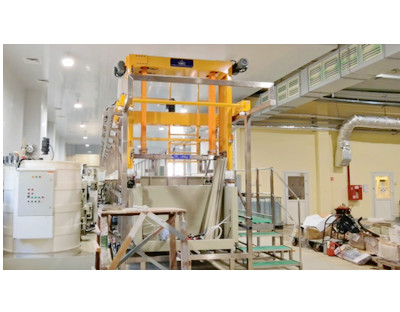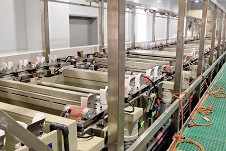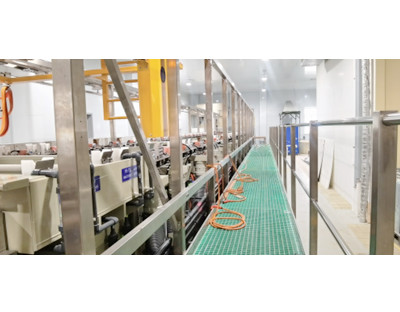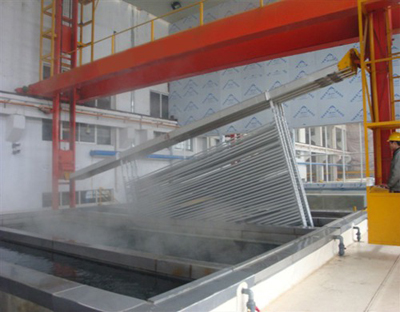1.1 Plating tanks
From the point of view of the production line, the fewer the number of tanks, the better. On the one hand, it can reduce the unnecessary running distance and time of the crane, on the other hand, it can also save the investment cost and the floor space.
Regarding the order of the tanks, the general situation should be considered from several factors such as production capacity, dripping pollution, crane operation and convenient operation. Nickel tanks should be drained as a spare due to the time-consuming maintenance.
For a production line with a production capacity of about 3KSF per day, a single crane can be designed to meet the production requirements. The recommended tank arrangement sequence is as follows:
(1)Loading and unloading, (2) (3) (4) three cascade counterflow rinsing, (5) Au recovery, (6) gold tank, (7) (8) Two cascade counterflow rinsing, (9) (10) double station nickel tank, (11) (12) spare double station nickel tank, (13) (14) Two cascade counterflow rinsing, (15) activation tank, (16) pre dip tank, (17) (18) Two-cascade counterflow rinsing, (19) Pickling tank, (20) (21) Two cascade counterflow rinsing, (22) Micro-etching tank, (23) (24) (25) Three cascade counterflow rinsing, (26) Degrease tank
For a production line with a production capacity of about 4.5 KSF per day, two cranes need to be designed to meet the production demand. The recommended tank arrangement sequence is as follows:
(1)Loading and unloading, (2) (3) (4) Three cascade counterflow rinsing, (5) Au recovery, (6) (7) double station nickel tank gold tank, (8) (9) Two cascade counterflow rinsing, (10) ) (11) (12) Three station nickel tank, (13) (14) (15) Spare three station nickel tank, (16) Degrease tank, (17) (18) (19) Three cascade counterflow rinsing, ( 20) Micro-etching tank, (21) (22) Two cascade counterflow rinsing, (23) Pickling tank, (24) (25) Two cascade counterflow rinsing, (26) Pre dip tank, (27) Activation tank, (28) )(29) Two cascade counterflow rinsing
For production numbers of about 6KSF per day, simply change the three station nickel tank to a four station nickel tank.
For larger production lines, consideration should be given to increase the width, depth and length of the tanks to increase the number of hanging boards per rack.
1.2 Hanging plate design
Regarding the size of the hanging window, the maximum horizontal hanging of the board is generally considered. For example, the 18″×24″ board should be hung horizontally on the 24″ side, otherwise the drop time of the potion on the board surface will increase by more than 30% compared with the horizontal hanging. Therefore, the effective width and effective depth of the nickel tank are generally about 26″×21″. Other tanks refer to the hanging plate space of the nickel tank.
This design can avoid problems such as poor potion exchange due to too deep nickel tanks. At the same time, for small-scale production, two rows can be hung to increase output and make up for the lack of nickel tank load.
Regarding the design of the hanger, the area where the hanger is soaked in the liquid medicine should be minimized to reduce the problem of the liquid medicine being carried out and the deposition of nickel and gold on the hanger. At the same time, aqua regia is generally used for nitrate hangers, and its operation is more difficult, so the convenience of maintenance should also be considered.
It is recommended to use PP plywood, 15 to 20 pieces of each hanger, and the thickness of each partition is preferably 10mm. The top is fixed with 316 stainless steel fixed plywood, and the bottom is fixed with a Teflon-coated U-shaped photo frame.
1.3 Tank material
Since the operating temperature of the nickel tank and the gold tank is 80~90℃, the tank body must not only be resistant to high temperature, but also not easy to leak. Therefore, 316 stainless steel is generally used as the nickel tank, and the tank wall is preferably mirror polished. Gold tanks generally use heat-resistant PP or stainless steel lined with Teflon. Other tanks can be made of ordinary PP material.
For nickel tanks, if only single and double panels are produced, heat-resistant PP can also be considered. But for the blind hole board, due to the complicated wiring, during the production process of immersion nickel gold, there may be mutual influence between the lines and it is easy to cause leakage plating. Therefore, the operation of the nickel tank is about 5 °C higher than that of the single and double boards, and even reaches 90 °C. above. For the nickel tank made of PP material, a large amount of nickel is inevitably deposited on the bottom of the tank, which brings many problems to the operation. Therefore, if the nickel tank and its accessories in the tank, including the heating and pumping system, are made of stainless steel , they can suppress nickel deposition through positive electrical protection, which not only makes the operation of the nickel tank easier, but also avoids unnecessary waste in terms of cost.
1.4 Program
In the production of immersion nickel gold, it is often impossible to produce only one or two kinds of plates. Since each type of plate making may require different activities, the immersion nickel gold production line preferably has more than four program segments to meet different production needs.
Pre- and post-processing equipment
2.1 Pre-treatment
Due to the problem of “poor color of gold surface” in the production of immersed nickel gold, adjusting the system activity and enhancing the micro-etching speed, although sometimes effective, is often time-consuming and labor-intensive, and these measures are very unsafe, and can produce another kind of scrap caused by inattentive measures. Therefore, under the conditions, another horizontal line is designed as a pretreatment, and the control of the parameter range of the immersion nickel gold is broadened by increasing the process.
Brushing → rinsing → micro-etching → rinsing → dry board
Brushing
Usually, a 500-1000# nylon brush reel is used to clean the copper surface in a water-spraying state to remove the chemical liquid remaining in the green oil process and the residual residue from the mild punching. If the green oil process is stable, or the possibility of problems is small, the grinding process does not need to be designed.
Micro-etching
Usually, 80-120g/L sodium persulfate and 5% sulfuric acid are used to prepare the bath solution. By adjusting the temperature, the micro-corrosion rate is controlled at about 1μm. Its function is to clean the copper surface. Remove the potion stains or serious oxidation and other copper surface debris left on the board surface in the previous process (mainly refers to green oil), so as to prevent the nickel immersion gold from appearing in the previous process.
It should be noted that if a horizontal microetching agent is used in the pretreatment, the microetching tank in the immersion nickel gold process still needs to be retained, but the micro-etching rate can reach 0.5μm, otherwise it will easily cause the problem of insufficient copper thickness.
2.2 Post treatment
Since the surface of immersion nickel gold is normally smooth and flat, slight oxidation or water stains on the gold surface will make the color of the gold surface unsightly. Even if the immersion nickel gold production line is optimally controlled, it can only prevent the oxidation of the gold surface.
The high-pressure rinsing machine can not only effectively clean the residual potion on the board surface to prevent the oxidation of the gold surface, but also the wind blows away the water droplets during the drying process, which completely avoids the problem of water stains caused by residual water droplets.
Some people also add a 2% pickling section before the high-pressure rinsing machine to wash off the oxidation of the gold surface caused by the gold tank. This is also a desirable method of remedy after the fact. Because the residual potion on the gold surface causes oxidation of the gold surface during the short rinsing process, it means that its attack on the gold surface is far greater than that of 2% hydrochloric acid or sulfuric acid, and the horizontal pickling process is also less than ten seconds. With high pressure water rinsing and dry board, its effect on the nickel-gold surface should be negligible.
Circulating filter pump, heating and agitation device
3.1 Circulating filter pump
In order to maintain a certain circulation effect of the bath liquid, each tank of degrease, micro-etching, activation, nickel immersion and gold immersion all need to be equipped with a circulating pump. Except the nickel tank, the above tanks also need to be equipped with a filter of 5μm filter element to filter the tank.
For the nickel tank, the circulation is not only required to be uniform, but also conducive to the diffusion of the liquid and the temperature, and the flow rate cannot be too fast to affect the deposition of chemical nickel. Usually, the circulation amount is 6-7 turn over. At the same time, the nickel tank needs to be filtered to remove the sundries in the bath. Since the cotton wick is prone to nickel, the bag filter system should be considered first. Regarding the overflow of the nickel tank, the main tank flows into the auxiliary tank, which is more conducive to the diffusion of the medicine and the temperature balance.
3.2 Heating device
A heating system is required for each tank of degrease, micro-etching, activation, immersion nickel and immersion gold. Except nickel and gold tank, quartz or Teflon heaters can be used for other tanks. For nickel tanks, it is best to use stainless steel heating exchange tubes, and external power-off protection is required. Because the auto dosing device is adding medicine in the auxiliary tank, it should be noted that the dosing port should not face the heater in the auxiliary tank.
3.3 Agitator
The main and auxiliary tanks of micro-etch and nickel tanks and each water rinsing tank should be equipped with an air pumping system. For nickel tanks, a strong pumping state should be maintained under each heating tube.
interface device
In the peripheral facilities of the immersion nickel-gold production line, DI water machine is needed first, and the DI water is required for the auxiliary tank of each medicine tank and the rinsing tank after activation, immersion nickel and gold recovery. Some plants use central DI water treatment, and the half pipeline is connected to the immersion gold line, which is the most ideal design.
In the production process, since the activation tank and the micro-etching tank have strict temperature requirements, a chiller should be purchased to control the temperature of the bath liquid. For the nickel tank, some people think that the cooling process is too slow (from the operating temperature to below 50 ℃), and the cold water pipe (temporary pipe) is connected to the nickel tank, which is also a good way to make full use of the existing resources.
Due to the large amount of nitric acid used in the nickel tank nitrate tank and the inconvenience of reuse, a standby nitric acid tank is connected at the bottom of the nickel tank to pump the nitric acid into the required tank through a water pumping motor (must be resistant to nitric acid) and a directional valve. It should be noted that the volume of the management tank (storing nitric acid) should be greater than 20-50% of the nickel tank.
In addition to the DI water machine, chiller and management tank, the surrounding facilities of immersion nickel gold must also extract the foul air from the production line and send it to the waste gas treatment tower for purification. At the same time, the production line should also be equipped with an air supply device to keep the air in the operating environment fresh.







 Mar. 02, 2022
Mar. 02, 2022 




